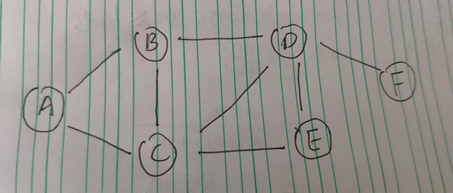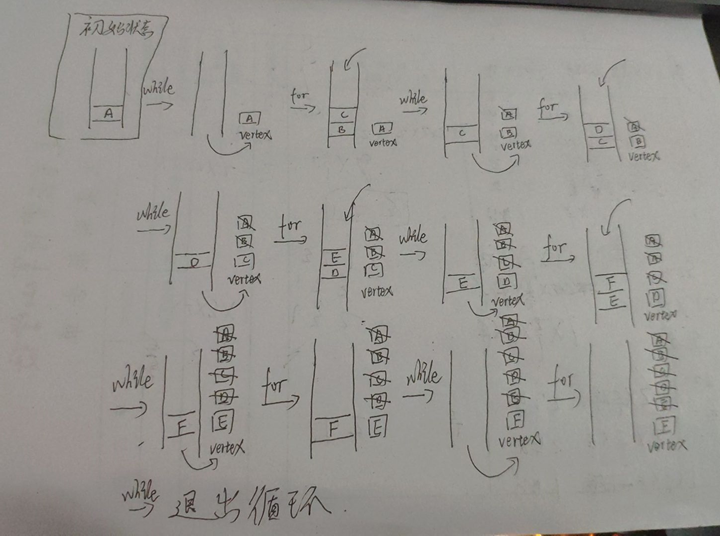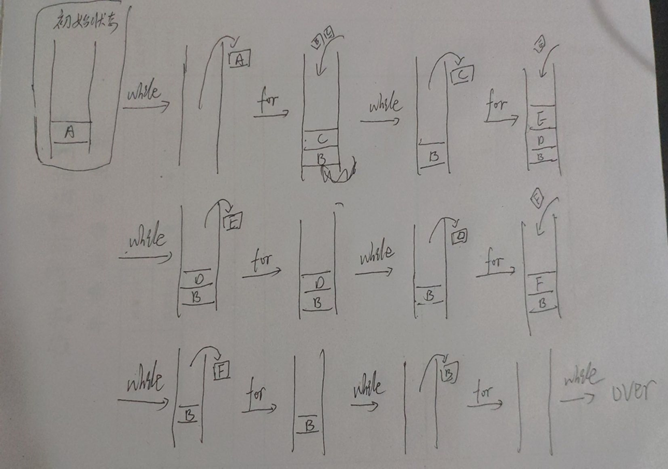BFS 和 DFS ( 1 )
参考:
https://www.bilibili.com/video/av25763384/?spm_id_from=333.788.videocard.0
https://blog.csdn.net/qq_34823530/article/details/99202899
一,代码

#define _CRT_SECURE_NO_WARNINGS #include<stdio.h> #include<stdlib.h> #include<vector> #include<queue> #include<stack> #include<map> using namespace std; map<char, vector<char>>v; // 邻接表 void BFS(char start) { queue<char>q; vector<int>vis; q.push(start); // 添加起点 vis.push_back(start); while (q.size()) { char vertex = q.front(); // 队首出队列 q.pop(); vector<char>vs = v[vertex]; // 取 vertex 的所有邻接点 for (int i = 0; i < vs.size(); i++) { char next = vs[i]; // 邻接点 auto ret = find(vis.begin(), vis.end(), next); if (ret == vis.end()) // 如果 next 没有遍历过的话 { q.push(next); vis.push_back(next); } } printf("%c ", vertex); }puts(""); } void DFS(char start) { stack<int>s; vector<char>vis; s.push(start); // 添加起点 vis.push_back(start); while (s.size()) { char vertex = s.top(); // 栈顶出队列 s.pop(); vector<char>vs = v[vertex]; // 取 vertex 的所有邻接点 for (int i = 0; i < vs.size(); i++) { char next = vs[i]; // 邻接点 auto ret = find(vis.begin(), vis.end(), next); if (ret == vis.end()) // 如果 next 没有遍历过的话 { s.push(next); vis.push_back(next); } } printf("%c ", vertex); }puts(""); } int main(void) { int n, m; while (scanf("%d%d", &n, &m) != EOF) { char s, s1, s2; scanf("%c%c%c", &s1, &s, &s2); // 起点 for (int i = 0; i < m; i++) { char t1, t2, t3, t4; scanf("%c%c%c%c", &t1, &t3, &t2, &t4); vector<char>vv = v[t1]; // 取出 t1 原来的所有邻接点 vv.push_back(t2); // 增加一个邻接点 v[t1] = vv; // 覆盖掉原来的邻接点 } printf("BFS:"); BFS(s); printf("DFS:"); DFS(s); } system("pause"); return 0; } /* 测试数据: 6 16 A A B A C B A B C B D C A C B C D C E D B D C D E D F E C E D F D 测试结果: BFS:A B C D E F DFS:A C E D F B */
二,过程解析
测试数据:

1,BFS
BFS 是利用队列实现的,由于队列是先进先出的,所以每次同时放进队列的同一个点的邻接点 A,B 都是按顺序来的。它是先 A 后 B。

2,DFS
DFS 是利用栈实现的,由于栈先进后出的。所以每次同时放进栈的同一个点的邻接点 A,B,并不按顺序遍历。它是先 A,在遍历 A 的所有子孙结点,再 B,再遍历 B 的所有子孙结点。

=========== ========== ========= ====== ===== ==== === == =


